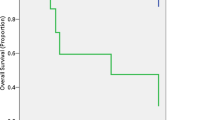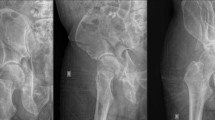Abstract
Purpose
The goal of this study is to compare the characteristics, clinical course, and mortality rates of acetabular fractures in the elderly population with respect to two types of injury.
Methods
We reviewed 183 consecutive patients with acetabular fractures aged 60 years old and older. One hundred eighty-three patients (129 men and 54 women) were included in the study with an average age of 70.2 years. There were 186 fractures, which included three cases of bilateral fractures. Patients were divided into two groups: low-energy injuries (group I), 56, and high-energy injuries (group II), 130. Patient characteristics and fracture pattern, as well as in-hospital mortality rates were compared between the low-energy and high-energy groups.
Results
Patient demographics and comorbidities were significantly different between the groups. In group I, the average age was 74.9 years, versus 68.2 years in group II (p < 0.001). The percent of females in each group was 39.3 % and 24.6 %, respectively (p = 0.043), and the average body mass index (BMI) was 25.6 and 28.4, respectively (p = 0.001). The Charlson comorbidity index was higher in group I (1.98 vs 0.95 in group II, p < 0.001). However, the American Society of Anesthesiologists physical status (ASA) was similar between groups (2.56 vs 2.53, respectively, p = 0.808). The proportion of surgical treatment was 44.6 % in group I and 61.6 % in group II (p = 0.019). Group II had a longer hospital stay (10.4 days vs 14.5 days, p = 0.025), but in-hospital death was not significantly different (5.3 % vs 7.9 %, respectively, p = 0.567).
Conclusion
Patients with acetabular fractures resulting from low-energy injuries were older and had lower BMI with more comorbidities. This study may highlight characteristics of fragility fractures of the acetabulum.
Similar content being viewed by others
References
Mears DC (1999) Surgical treatment of acetabular fractures in elderly patients with osteoporotic bone. J Am Acad Orthop Surg 7(2):128–141
WHO (1998) Guidelines for preclinical evaluation and clinical trials in osteoporosis. World Health Organization, Geneva
Dell R, Greene D, Schelkun SR, Williams K (2008) Osteoporosis disease management: the role of the orthopaedic surgeon. J Bone Joint Surg Am 90(Suppl 4):188–194. doi:10.2106/JBJS.H.00628
Lin JT, Lane JM (2004) Osteoporosis: a review. Clin Orthop Relat Res 425:126–134
Rowe SM, Yoon TR, Ryang DH (1993) An epidemiological study of hip fracture in Honam, Korea. Int Orthop 17(3):139–143
Carretta E, Bochicchio V, Rucci P, Fabbri G, Laus M, Fantini MP (2011) Hip fracture: effectiveness of early surgery to prevent 30-day mortality. Int Orthop 35(3):419–424. doi:10.1007/s00264-010-1004-x
Khan MA, Hossain FS, Ahmed I, Muthukumar N, Mohsen A (2013) Predictors of early mortality after hip fracture surgery. Int Orthop 37(11):2119–2124. doi:10.1007/s00264-013-2068-1
Saracen A, Kotwica Z (2014) Treatment of multiple osteoporotic vertebral compression fractures by percutaneous cement augmentation. Int Orthop 38(11):2309–2312. doi:10.1007/s00264-014-2470-3
Rosa MA, Maccauro G, D’Arienzo M (1999) Bilateral acetabular fracture without trauma. Int Orthop 23(2):120–121
Charlson M, Szatrowski TP, Peterson J, Gold J (1994) Validation of a combined comorbidity index. J Clin Epidemiol 47(11):1245–1251
American Society of Anesthesiologists. ASA Physical Status Classification System. Available at: http://asahq.org/resources/clinical-information/asa-physical-status-classification-system
Letournel E (1980) Acetabulum fractures: classification and management. Clin Orthop Relat Res 151:81–106
Bergstrom U, Bjornstig U, Stenlund H, Jonsson H, Svensson O (2008) Fracture mechanisms and fracture pattern in men and women aged 50 years and older: a study of a 12-year population-based injury register, Umea, Sweden. Osteoporos Int 19(9):1267–1273. doi:10.1007/s00198-007-0549-z
Chuang-Stein C, Tong DM (1995) Multiple comparisons procedures for comparing several treatments with a control based on binary data. Stat Med 14(23):2509–2522
Ferguson TA, Patel R, Bhandari M, Matta JM (2010) Fractures of the acetabulum in patients aged 60 years and older: an epidemiological and radiological study. J Bone Joint Surg Br 92(2):250–257. doi:10.1302/0301-620X.92B2.22488
Vanderschot P (2007) Treatment options of pelvic and acetabular fractures in patients with osteoporotic bone. Injury 38(4):497–508. doi:10.1016/j.injury.2007.01.021
Kanis JA, Johnell O, Oden A, Johansson H, McCloskey E (2008) FRAX and the assessment of fracture probability in men and women from the UK. Osteoporos Int 19(4):385–397. doi:10.1007/s00198-007-0543-5
Brauer CA, Coca-Perraillon M, Cutler DM, Rosen AB (2009) Incidence and mortality of hip fractures in the United States. JAMA 302(14):1573–1579. doi:10.1001/jama.2009.1462
Katz JN, Chang LC, Sangha O, Fossel AH, Bates DW (1996) Can comorbidity be measured by questionnaire rather than medical record review? Med Care 34(1):73–84
Poses RM, McClish DK, Smith WR, Bekes C, Scott WE (1996) Prediction of survival of critically ill patients by admission comorbidity. J Clin Epidemiol 49(7):743–747
Belmont PJ Jr, Garcia EJ, Romano D, Bader JO, Nelson KJ, Schoenfeld AJ (2014) Risk factors for complications and in-hospital mortality following hip fractures: a study using the National Trauma Data Bank. Arch Orthop Trauma Surg 134(5):597–604. doi:10.1007/s00402-014-1959-y
Frost SA, Nguyen ND, Black DA, Eisman JA, Nguyen TV (2011) Risk factors for in-hospital post-hip fracture mortality. Bone 49(3):553–558. doi:10.1016/j.bone.2011.06.002
Bible JE, Wegner A, McClure JM, Kadakia RJ, Richards JE, Bauer JM, Mir HR (2013) One-year mortality after acetabular fractures in elderly patients presenting to a level-one trauma center. J Orthop Trauma 28(3):154-159. doi:10.1097/BOT.0b013e31829e801b
Ferguson TA, Patel R, Bhandari M, Matta JM (2010) Fractures of the acetabulum in patients aged 60 years and older: an epidemiological and radiological study. J Bone Joint Surg (Br) 92(2):250–257. doi:10.1302/0301-620X.92B2.22488
Culemann U, Holstein JH, Kohler D, Tzioupis CC, Pizanis A, Tosounidis G, Burkhardt M, Pohlemann T (2010) Different stabilisation techniques for typical acetabular fractures in the elderly—a biomechanical assessment. Injury 41(4):405–410. doi:10.1016/j.injury.2009.12.001
Conflicts of interest
The authors declare no conflict of interest in relation to the preparation of this paper.
Author information
Authors and Affiliations
Corresponding author
Rights and permissions
About this article
Cite this article
Kim, J.W., Herbert, B., Hao, J. et al. Acetabular fractures in elderly patients: a comparative study of low-energy versus high-energy injuries. International Orthopaedics (SICOT) 39, 1175–1179 (2015). https://doi.org/10.1007/s00264-015-2711-0
Received:
Accepted:
Published:
Issue Date:
DOI: https://doi.org/10.1007/s00264-015-2711-0




